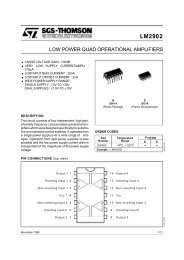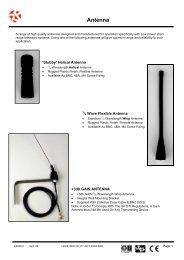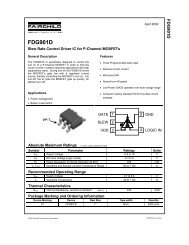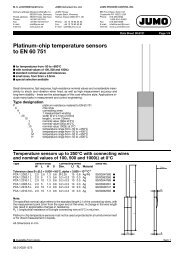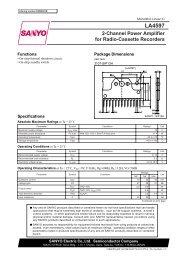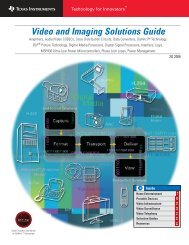Interface Selection Guide
Interface Selection Guide
Interface Selection Guide
You also want an ePaper? Increase the reach of your titles
YUMPU automatically turns print PDFs into web optimized ePapers that Google loves.
32 GTLP (Gunning Transceiver Logic Plus)<br />
➔<br />
Design Considerations<br />
Primary<br />
Speed—The speed of the GTLP family in<br />
parallel backplanes is 4X that of traditional<br />
logic. Optimized output edge-rate control<br />
(OEC) circuitry allows clock frequencies<br />
in excess of 100 MHz in high-performance<br />
system backplane applications.<br />
Voltage Range—The GTLP family operates<br />
at 3.3 V and with 5-V tolerant LVTTL<br />
inputs/outputs and can operate in a<br />
mixed-voltage environment. GTLP acts as<br />
LVTTL -to-GTLP bi-directional translators<br />
with 5 V tolerance on the LVTTL port.<br />
Drive—The GTLP family provides<br />
±24-mA drive on the A-Port (LVTTL side)<br />
and the choice of medium (50 mA) or<br />
high (100 mA) drive on the B-Port (GTLP<br />
side). This offers flexibility in matching<br />
the device to backplane length, slot<br />
spacing and termination resistance.<br />
Signal Integrity–TI-OPC —Overshoot<br />
protection circuitry was designed<br />
specifically for the GTLP family and<br />
incorporated into the GTLP outputs.<br />
TI-OPC actively clamps any overshoots<br />
that are caused by improperly terminated<br />
backplanes, unevenly distributed cards<br />
or empty slots. OEC on the rising and<br />
falling edge of the GTLP outputs reduces<br />
line reflections and extra EMI, improving<br />
overall signal integrity.<br />
True Live Insertion—GTLP backplane<br />
drivers allow for Level 3 isolation and<br />
true live-insertion capability. Level 1 isolation,<br />
partial power-down: I OFF circuitry<br />
within the device prevents damage by<br />
limiting the current flowing from an energized<br />
bus when the device V CC goes to<br />
zero. Level 2 isolation, hot insertion: both<br />
I OFF and power-up 3-state (PU3S) circuitry<br />
allow insertion or removal of a board into<br />
a backplane without powering down the<br />
host system and without suspending<br />
signaling. Level 3 isolation, live insertion:<br />
for live insertion both I OFF and PU3S<br />
circuitry are needed and the board I/Os<br />
must be precharged to mid-swing levels<br />
prior to connector insertion/removal.<br />
Secondary<br />
Compatibility—GTLP provides an easy<br />
migration path from traditional backplane<br />
logic like ABT, FCT, LVT, ALVT, LVC and<br />
FB+.<br />
Portfolio—TI offers the broadest GTLP<br />
portfolio in the industry, with both highdrive<br />
(100 mA) and medium-drive<br />
(50 mA) devices.<br />
Packaging—TI offers GTLP in a lowprofile,<br />
fine-pitch BGA package (LFBGA)<br />
and in a quad flat no-lead package (QFN)<br />
for higher performance and the ultimate<br />
reduction in board-space requirements.<br />
Single Bit Representation of a Multipoint Parallel Backplane<br />
V TT<br />
V TT<br />
22 Ω 0.25" .94" .94"<br />
.94" .94" 0.25" 22 Ω<br />
Z 0 †<br />
Conn. Conn. Conn. Conn. Conn. Conn.<br />
1" Z 0 ¥ 1" 1" 1" 1" 1"<br />
Rcvr Rcvr Rcvr Rcvr Rcvr<br />
Rcvr<br />
Slot 1 Slot 2 Slot 3 Slot 18 Slot 19 Slot 20<br />
† Unloaded backplane trace natural impedance (Z 0) is 45 Ω to 60 Ω, with 60 Ω being ideal.<br />
¥ Card stub natural impedance (Z 0) is 60 Ω.<br />
Signal Integrity: TI vs Competition<br />
2<br />
TI<br />
Competitor A<br />
1.5<br />
Volts<br />
1<br />
0.5<br />
0<br />
1.98E-08<br />
4.48E-08<br />
Time<br />
6.98E-08<br />
<strong>Interface</strong> <strong>Selection</strong> <strong>Guide</strong> Texas Instruments 3Q 2005



